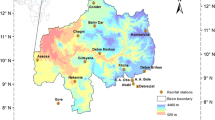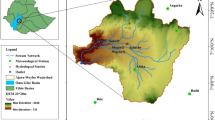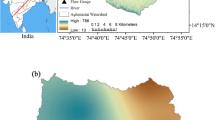Abstract
The drawdown trend of the water level in Urmia Lake poses a serious problem for northwestern Iran which has had negative impacts on agriculture and industry. This research investigated likely causes of the predicament by estimating trends in the time series of hydroclimatic variables of the basin. Three non-parametric statistical tests, the Mann–Kendall, Spearman rho, and Sen’s T, were applied to estimate the trends in the annual and seasonal time series of temperature, precipitation, and streamflow at 95 stations throughout the basin. The Theil–Sen method was also used to estimate the slopes of trend lines of annual time series. The results showed a significant increasing trend of temperature throughout the basin and an area-specific precipitation trend. The tests also confirmed a general decreasing trend in the basin streamflow that was more pronounced in the downstream stations. The annual trend line slope was found to be from 0.02 to 0.14 °C/year, −7.5 to 3.8 mm/year, and −0.01 to −0.4 m3/s/year for temperature, precipitation, and streamflow, respectively. The homogeneity of the monthly trends was also evaluated using the Van Belle and Hughes tests as confirmation. Temporal analyses of the trends for the temperature and streamflow of the basin detected significant increasing trends beginning in the mid-1980s and 1990s. The correlations between streamflow and climate variables (temperature and precipitation) were detected by Pearson’s test. The results showed that the streamflow in Urmia Lake basin is more sensitive to changes in temperature than precipitation. In general, the decline in the lake water level can be related to both the increase of temperature in the basin and an improvement in over-exploitation of the water resources.
















Similar content being viewed by others
References
Bandyopadhyay A, Bhadra A, Raghuwanshi NS, Singh R (2009) Temporal trends in estimates of reference evapotranspiration over India. J Hydrol Eng 14(5):508–515
Brunetti M, Buffoni L, Maugeri M, Nanni T (2000) Precipitation intensity trends in northern Italy. Int J Climatol 20(9):1017–1031
Burn HB, Elnur MAH (2002) Detection of hydrologic trends and variability. J Hydrol 255:107–122
Chen H, Guo SL, Xu CY, Singh VP (2007) Historical temporal trends of hydro-climatic variables and runoff response to climate variability and their relevance in water resource management in the Hanjiang basin. J Hydrol 344(3):171–184. doi:10.1016/j.jhydrol.2007.06.034
Dinpashoh Y, Jhajharia D, Fakheri-Fard A, Singh VP, Kahya E (2011) Trends in reference crop evapotranspiration over Iran. J Hydrol 399(3):422–433
Dinpashoh Y, Mirabbasi R, Jhajharia D, Abianeh HZ, Mostafaeipour A (2013) Effect of short term and long-term persistence on identification of temporal trends. Journal of Hydrologic Engineering.
Douglas EM, Vogel RM, Kroll CN (2000) Trends in floods and low flows in the United States: impact of spatial correlation. J Hydrol 240(1):90–105. doi:10.1016/S0022-1694(00)00336-X
Duan K, Yao T, Thompson LG (2006) Response of monsoon precipitation in the Himalayas to global warming. J Geophys Res 111(D19), D19110. doi:10.1029/2006JD007084
Eimanifar A, Mohebbi F (2007) Urmia Lake (northwest Iran): a brief review. Saline Systems 3(5):1–8
Fan X, Wang M (2011) Change trends of air temperature and precipitation over Shanxi Province, China. Theor Appl Climatol 103(3–4):519–531. doi:10.1007/s00704-010-0319-2
Feidas H, Makrogiannis T, Bora-Senta E (2004) Trend analysis of air temperature time series in Greece and their relationship with circulation using surface and satellite data: 1955–2001. Theor Appl Climatol 79:185–208. doi:10.1007/s00704-004-0064-5
Ghahraman B, Taghvaeian S (2008) Investigation of annual rainfall trends in Iran. J Agric Sci Technol 10:93–97
Githui F. W (2009) Assessing the impacts of environmental change on the hydrology of the Nzoia catchment, in the Lake Victoria Basin. Dissertation, Vrije University Brussel
Golabian H (2011) Urumia Lake: hydro-ecological stabilization and permanence. In: Macro-engineering seawater in unique environments. Springer, Berlin, pp 365–397
Groisman PY, Knight RW, Karl TR (2001) Heavy precipitation and high stream flow in the contiguous United States: trends in the twentieth century. Bull Am Meteorol Soc 82(2):219–246
Hassanzadeh E, Zarghami M, Hassanzadeh Y (2012) Determining the main factors in declining the Urmia Lake level by using system dynamics modeling. Water Resour Manag 26:129–145. doi:10.1007/s11269-011-9909-8
Huth R, Pokorná L (2004) Parametric versus non-parametric estimates of climatic trends. Theor Appl Climatol 77:107–112. doi:10.1007/s00704-003-0026-3
IPCC (2001) The scientific basis of climate change, contribution of working I to the third assessment report of the Intergovernmental Panel on Climate Change. Cambridge University Press, Cambridge
Jahanbakhsh-Asl S, Ghavidel Rahimi Y (2003) Modeling of precipitation trend and drought prediction in Urmia Lake basin. Journal of Social and Human Sciences (in Persian)
Jalili Sh (2010) Spectral analysis of Lake Urmia level time series and impact of climate and hydrological variables on it. Dissertation, Tarbiat Modares University, Iran
Jhajharia D, Dinpashoh Y, Kahya E, Singh VP, Fakheri-Fard A (2012) Trends in reference evapotranspiration in the humid region of northeast India. Hydrol Process 26(3):421–435
Kahya E, Kalaycı S (2004) Trend analysis of streamflow in Turkey. J Hydrol 289:128–144. doi:10.1016/j.jhydrol.2003.11.006
Katiraei PS, Hejam S, Iran Nejad P (2006) Frequency changes and intensity of daily precipitation in trend precipitation of Iran during 1960 to 2001. Journal of Geophysics and Space 33(1) (in Persian)
Kendall MG (1975) Rank correlation methods. Charles Griffin, London
Kumar S, Merwade V, Kam J, Thurner K (2009) Streamflow trends in Indiana: effects of long term persistence, precipitation and subsurface drains. J Hydrol 374:171–183. doi:10.1016/j.jhydrol.2009.06.012
Lettenmaier DP, Wood EF, Wallis JR (1994) Hydroclimatological trends in the continental United States 1948–1988. J Clim 7:586–607. doi:10.1175/1520-0442(1994) 007
Mann HB (1945) Nonparametric tests against trend. Econometrica 13(3):245–259. http://www.jstor.org/stable/1907187
Masih I, Uhlenbrook S, Maskey S, Smakhtin V (2010) Streamflow trends and climate linkages in the Zagros Mountains, Iran. Climate Change 104(2):317–338. doi:10.1007/s10584-009-9793-x
McCuen RH (2003) Modelling hydrologic change: statistical methods. Lewis, Boca Raton
Ministry of Energy (2010) Integrated water plan in Urmia Lake basin. Technical report of Water and Wastewater Planning Office
Mosmann V, Castro A, Fraile R, Dessens J, Sanchez JL (2004) Detection of statistically significant trends in the summer precipitation of mainland Spain. Atmos Res 70:43–53
Murphy BF, Timbal B (2008) A review of recent climate variability and climate change in south eastern Australia. Int J Climatol 28(7):859–879. doi:10.1002/joc.1627
Pal I, Al-Tabbaa A (2011) Assessing seasonal precipitation trends in India using parametric and non-parametric statistical techniques. Theor Appl Climatol 103:1–11. doi:10.1007/s00704-010-0277-8
Partal T, Kahya E (2006) Trend analysis in Turkey precipitation data. Hydrol Process 20:2011–2026. doi:10.1002/hyp.5993
Partal T, Kucuk M (2006) Long-term trend analysis using discrete wavelength components of annual precipitations measurements in Marmara region (Turkey). Phys Chem Earth 31:1189–1200
Rezaei Banafsheh M, Sarafrozeh F, Jalali T (2010) Investigation of the trend analysis of extreme value of daily temperature and precipitation in Urmia Lake basin. J Geo Plan 38(16):43–74 (in Persian)
Sabziparvar AA, Tabari A, Aeini A, Ghafouri M (2010) Evaluation of class A pan coefficient models for estimation of reference crop evapotranspiration in cold semi-arid and warm arid climates. Water Resour Manag 24(5):909–920. doi:10.1007/s11269-009-9478-2
Sen PK (1968) Asymptotically efficient tests by the method of n rankings. J. Roy. Statist. Soc. Ser. B. 30
Shahid S (2011) Trends in extreme rainfall events of Bangladesh. Theoret App Climatol 104(3–4):489–499
Sneyers R (1991) On the statistical analysis of series of observations. World Meteorological Organization. Technical note no 143
Stafford JM, Wendler G, Curtis J (2000) Temperature and precipitation of Alaska: 50 year trend analysis. Theoret App Climatol 67:33–44. doi:10.1007/s007040070014
Tabari H, Abghari H, Hosseinzadeh Talaee P (2012) Temporal trends and spatial characteristics of drought and rainfall in arid and semiarid regions of Iran. Hydrol Process 26(22):3351–3361
Theil H (1950) A rank-invariant method of linear and polynomial regression analysis, part 3. Proceedings of Koninalijke Nederlandse Akademie van Weinenschatpen A 53:1397–1412
Van Belle G, Hughes JP (1984) Nonparametric tests for trend in water quality. Water Resour Res 20(1):127–136. doi:10.1029/WR020i001p00127
Wu Z, Huang NE, Long SR, Peng CK (2007) On the trend, detrending, and variability of nonlinear and nonstationary time series. Proc Natl Acad Sci 104(38):14889–14894
Yue S, Hashino M (2003) Long term trends of annual and monthly precipitation in Japan. J Am Water Resour Assoc 39(3):587–596
Yue YS, Zou S, Whittemore D (1993) Non-parametric trend analysis of water quality data of rivers in Kansas. J Hydrol 150:61–80. doi:10.1016/0022-1694(93)90156-4
Yue S, Pilon P, Cavadias G (2002) Power of the Mann–Kendall and Spearman’s rho test for detecting monotonic trends in hydrological series. J Hydrol 259:254–271. doi:10.1016/S0022 1694(01)00594-7
Zarghami M (2011) Effective watershed management; case study of Urmia Lake, Iran. Lake Reserv Manag 27(1):87–94
Zhang X, Vincent LA, Hogg WD, Niitsoo A (2000) Temperature and precipitation trends in Canada during the 20th century. Atmospheric Ocean 38:395–429
Zhang X, Harvey KD, Hogg WD, Yuzyk TR (2001) Trends in Canada streamflow. Water Resour Res 37:987–998. doi:10.1029/2000WR900357
Zhang Q, Chen JQ, Zhang ZX (2005) Observed climatic changes in Shanghai during 1873–2002. J Geogr Sci 15(2):217–222. doi:10.1007/BF02872687
Zhang Q, Liu C, Xu CY, Xu YP, Jiang T (2006) Observed trends of annual maximum water level and streamflow during past 130 years in the Yangtze River basin, China. J Hydrol 324(1–4):255–265. doi:10.1016/j.jhydrol.2005.09.023
Zhao G, Hormann G, Fohrer N, Zhang Z, Zhai J (2010) Streamflow trends and climate variability impacts in Poyang Lake Basin, China. Water Resour Manag 24:689–706. doi:10.1007/s11269-009-9465-7
Zubair L, Siriwardhana M, Chandimala J, Yahiya Z (2008) Predictability of Sri Lankan rainfall based on ENSO. Int J Climatol 28:91–101
Author information
Authors and Affiliations
Corresponding author
Rights and permissions
About this article
Cite this article
Fathian, F., Morid, S. & Kahya, E. Identification of trends in hydrological and climatic variables in Urmia Lake basin, Iran. Theor Appl Climatol 119, 443–464 (2015). https://doi.org/10.1007/s00704-014-1120-4
Received:
Accepted:
Published:
Issue Date:
DOI: https://doi.org/10.1007/s00704-014-1120-4




